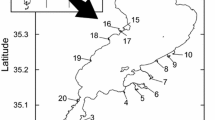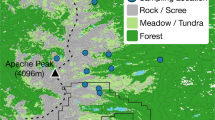Abstract
To understand how littoral biota respond to anthropogenic disturbances, limnologists seek to detect the scale at which patterns and processes occur. We conducted an extensive study on the shoreline phytobenthos of Lake Garda (Italy) with the following main objectives: (i) to examine the importance of urbanization for species distribution within a set of hierarchical spatial scales (101–104 m), and then (ii) to test the spatio-temporal interactions on a reduced set of scales (101–102 m, and 101–102 days). Results showed that most of the variation in most abundant species and habitat characteristics occurred at the spatial scale of 101–102 m. Species richness was positively related with microheterogeneity, but the relationship occurred only at low urbanization and not at highly-urbanized sites where artificial shores were less heterogeneous. The similarity of species assemblages was regulated by two interacting processes, one operating at a fine spatial scale (102 m), reflecting the physical-habitat requirements of the species, and the other one operating at a broader scale (104 m) in relation to the N–S nitrogen gradient. Overall, time explained 73 % of the total variation of species assemblages, space 7 %, and 20 % was explained by the interaction between space and time (the patch scale, 10s of m, and area scale, 100s of m, interacted with the finest temporal scale, 10s of days). This interaction might be explained by the process of species recruitment operating at different rates at the two spatial scales. Since the largest variation in species assemblages was at the temporal scale (due to the seasonal succession of phytobenthos), we recommend collecting at least one sample per season when monitoring littoral habitats.





Similar content being viewed by others
References
Anderson MJ (2001) A new method for non-parametric multivariate analysis of variance. Aust Ecol 26:32–46
APHA (2000) Standard Methods for the Examination of Water and Wastewater. 20th edn., APHA, AWWA & WEF, American Public Health Association. Washington, DC
Arbuckle KE, Downing JA (2001) The influence of watershed land use on lake N:P in a predominantly agricultural landscape. Limnol Oceanogr 46:970–975
Benedetti-Cecchi L (2000) Predicting direct and indirect interactions during succession in a midlittoral rocky shore assemblage. Ecol Monogr 70:45–72
Benedetti-Cecchi L (2001) Variability in abundance of algae and invertebrates at different spatial scales on rocky sea shores. Mar Ecol Prog Ser 215:79–92
Brauns M, Gücker B, Wagner C, Garcia XF, Walz N, Pusch M (2011) Human lakeshore development alters the structure and trophic basis of littoral macroinvertebrate food webs. J Appl Ecol 48:916–925
Brazner JC, Danz NP, Trebitz AS, Niemi GJ, Regal RR, Hollenhorst T, Host GE, Reavie ED, Brown TN, Hanowski JM, Johnston CA, Johnson LB, Howe RW, Ciborowski JJH (2007) Responsiveness of Great Lakes wetland indicators to human disturbances at multiple spatial scales: a multi-assemblage assessment. J Great Lakes Res 33(3):42–66
Bulleri F, Chapman MG (2004) Intertidal assemblages on artificial and natural habitats in marinas on the north-west coast of Italy. Mar Biol 145:381–391
Cardinale BJ, Palmer MA, Swan CM, Brooks S, Poff NL (2002) The influence of substrate heterogeneity on biofilm metabolism in a stream ecosystem. Ecology 83(2):412–422
Carpenter SR, Caraco NF, Correll DL, Howarth RW, Sharpley AN, Smith VH (1998) Nonpoint pollution of surface waters with phosphorus and nitrogen. Ecol Appl 8:559–568
Chase JM, Leibold MA (2003) Ecological niches: linking classical and contemporary approaches. The University of Chicago Press, Chicago
Christensen DL, Herwig BR, Schindler DE, Carpenter SR (1996) Impacts of lakeshore residential development on coarse woody debris in north temperate lakes. Ecol Appl 6:1143–1149
Dudgeon D, Arthington AH, Gessner MO, Kawabata Z, Knowler D, Lévêque C, Naiman RJ, Prieur-Richard AH, Soto D, Stiassny MLJ (2006) Freshwater biodiversity: importance, threats, status, and conservation challenges. Biol Rev 81:163–182
Fraschetti S, Terlizzi A, Benedetti-Cecchi L (2005) Patterns of distribution of marine assemblages from rocky shores: evidence of relevant scales of variation. Mar Ecol Prog Ser 296:13–29
Geitler L (1932) Cyanophyceae. In: Rabenhorst’s Kryptogamen Flora von Deutschland, Österreich und der Schweiz, Leipzig 14:1–1196
Havens KE, Bull LA, Warren GL, Crisman TL, Phlips EJ, Smith JP (1996) Food web structure in a subtropical lake ecosystem. Oikos 75:20–32
Holyoak M, Leibold MA, Holt RD (2005) Metacommunities. Spatial dynamics and ecological communities. The University of Chicago Press, Chicago
Jacoby JM, Bouchard DD, Patmont CR (1991) Response of periphyton to nutrient enrichment in Lake Chelan, WA. Lake Reserv Manage 7:33–43
John DM, Whitton BA, Brook AJ (2002) The Freshwater Algal Flora of the British. Cambridge University Press, Cambridge
Johnson RK, Goedkoop W (2002) Littoral macroinvertebrate communities: spatial scale and ecological relationships. Fresh Biol 47:1840–1854
Johnson RK, Goedkoop W, Sandin L (2004) Spatial scale and ecological relationships between the macroinvertebrate communities of stony habitats of streams and lakes. Fresh Biol 49:1179–1194
Kahlert M, Hasselrot AT, Hillebrand H, Pettersson K (2002) Spatial and temporal variation in the biomass and nutrient status of epilithic algae in Lake Erken, Sweden. Fresh Biol 47:1191–1215
Keddy PA (1982) Quantifying within-lake gradients of wave energy: interrelationships of wave energy, substrate particle size and shoreline plants in Axe Lake, Ontario. Aq Bot 14:41–58
Komárek J, Anagnostidis K (1999) Cyanoprokaryotes-1. Teil: Chroococcales–Süßwasserflora von Mitteleuropa 19/1, pp 1–548
Komárek J, Anagnostidis K (2005) Cyanoprokaryotes-2. Teil: Oscillatoriales–Süßwasserflora von Mitteleuropa 19/2, pp 1–759
Levin SA (1992) The problem of pattern and scale in ecology: the Robert H. MacArthur award lecture. Ecology 73:1943–1967
Madsen JD, Chambers PA, James WF, Koch EW, Westlake DF (2001) The interaction between water movement, sediment dynamics and submersed macrophytes. Hydrobiol 444:71–84
Ogdahl ME, Lougheed VL, Stevenson RJ, Steinman AD (2010) Influences of multi-scale habitat on metabolism in a coastal Great Lakes watershed. Ecosystems 13:222–238
Ostendorp W, Iseli C, Krauss M, Krumscheidplankert P, Moret JL, Rollier M, Schanz F (1995) Lake shore deterioration, reed management and bank restoration in some central European lakes. Ecol Eng 5:51–75
Peters DPC, Bestelmeyer BT, Turner MG (2007) Cross–scale interactions and changing pattern–process relationships: consequences for system dynamics. Ecosystems 10:790–796
R Development Core Team (2012) R: a language and environment for statistical computing, Vienna, Austria. http://www.R-project.org
Rosenberger EE, Hampton SE, Fradkin SC, Kennedy BP (2008) Effects of shoreline development on the nearshore environment in large deep oligotrophic lakes. Fresh Biol 53:1673–1691
Salmaso N (2010) Long-term phytoplankton community changes in a deep subalpine lake: responses to nutrient availability and climatic fluctuations. Fresh Biol 55:825–846
Salmaso N, Decet F, Cordella P (1999) Understanding deep oligotrophic subalpine lakes for efficient management. Hydrobiol 395(396):253–263
Scheuerell MD, Schindler DE (2004) Changes in the spatial distribution of fishes in lakes along a residential development gradient. Ecosystems 7:98–106
Schneider DC (2001) The rise of the concept of scale in ecology. Bioscience 51(7):545–553
Spitale D, Scalfi A, Lange Bertalot H, Cantonati M (2011) Using different epilithic-diatom assemblage metrics for an ecological characterization of the shores of Lake Garda. J Limnol 70(2):197–208
Spitale D, Scalfi A, Cantonati M (2012) Niche partitioning, shape of species response, and diversity in the phytobenthos across the rocky shoreline of a large peri-Alpine lake. J Gr. Lakes Res 38:620–627
Stoffels RJ, Clarke KR, Closs GP (2005) Spatial scale and benthic community organisation in the littoral zones of large oligotrophic lakes: potential for cross-scale interactions. Fresh Biol 50:1131–1145
Suurkuukka H, Meissner KK, Muotka T (2012) Species turnover in lake littorals: spatial and temporal variation of benthic macroinvertebrate diversity and community composition. Divers Distrib, pp 1–11
Underwood AJ (1997) Experiments in ecology: their logical design and interpretation using analysis of variance. Cambridge University Press, Cambridge
Underwood AJ, Chapman MG (1996) Scales of spatial patterns of distribution of intertidal invertebrates. Oecologia 107:212–224
Vadeboncoeur Y, Steinman AD (2002) Periphyton function in lake ecosystems. Sci World J 2:1449–1468
Vadeboncoeur Y, Vander Zanden MJ, Lodge DM (2002) Putting the lake back together: reintegrating benthic pathways into Lake food web models. Bioscience 52:44–55
Wiens JA (1989) Spatial scaling in ecology. Funct Ecol 3(4):385–397
Acknowledgments
This work was funded by the University and Scientific Research Department of the Autonomous Province of Trento (ACE-SAP Project-Alpine ecosystems in a changing environment: biodiversity sensitivity and adaptive potential, 2008–2011). The authors would like to thank Prof. Lisandro Benedetti-Cecchi (University of Pisa, Italy) for the useful indications on the ANOVA models.
Author information
Authors and Affiliations
Corresponding author
Electronic supplementary material
Below is the link to the electronic supplementary material.
Rights and permissions
About this article
Cite this article
Spitale, D., Scalfi, A. & Cantonati, M. Urbanization effects on shoreline phytobenthos: a multiscale approach at lake extent. Aquat Sci 76, 17–28 (2014). https://doi.org/10.1007/s00027-013-0307-6
Received:
Accepted:
Published:
Issue Date:
DOI: https://doi.org/10.1007/s00027-013-0307-6




